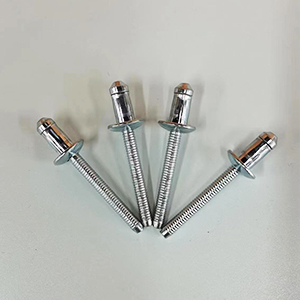Seahorse rivet is a structural rivet that uses interference lock technology and has excellent shear strength and tensile strength.
Haima rivets have high tensile and shear resistance, provide strong earthquake-resistant joint connections, have high earthquake resistance and a large blind end load-bearing area. The special structure reduces the pressure of the rivet on the workpiece, ensuring that the workpiece is not easily deformed and the rivets are not easily deformed during installation. The large nail tail is easy to disperse the load, the rivet port is flat, and the locking ability is strong. It is suitable for riveting fields that require high riveting strength and sealing performance.
characteristic:
1. Extra high shear strength and tensile strength;
2. The larger blind end bearing surface disperses the axial load\/clamping load acting on the blind end workpiece;
3. The spline locking nail core structure design provides a strong anti-seismic connection and prevents abnormal noise;
4. When used in special occasions, it can complete axial fixation and radial rolling functions;
use:
Haima rivets are suitable for metals, plastics and composite materials; Haima rivets are widely used in various vehicles, ships, buildings, warehouse shelves, freight elevators, distribution cabinets, etc. to rivet various thin structural parts.
The available diameter series of hippocampus blind rivets are 6.4 and 7.8.
When selecting Haima rivets, you should pay attention to the thickness of the riveted workpiece not exceeding or lower than the riveting range.
The functional inspection method of Haima rivets is in accordance with GB\/T 3098.18-2004 (ISO14589:2000).
Supporting tools:
Haima rivets are high-strength structural rivets with high nail-breaking force and require the use of a special Haima rivet gun with high pulling force;

Related Industry Knowledge
- Types and uses of rivets
- Use of rivet gun
- Application and characteristics of lantern rivets
- Dealing with surface problems and common phenomena of blind rivets
- Rivet nuts and their installation and precautions
- Introduction of seahorse rivets
- The difference between ring groove rivets and groove rivets
- The use and precautions of ring groove rivets
- Development and working principle of blind rivets
- Uses and advantages of large brim blind rivets
- Advantages and applications of blind rivets
- Introduction to types of riveting guns
- Application scope of brushed rivets
- Characteristics of lantern rivets
- The uses and operating precautions of ring groove rivets
- Introduction to application and performance of wire drawing rivets
- Operating requirements for ring groove rivets
- How can ring groove rivets be used to reduce erroneous operations?
- Advantages of brushed rivets
- Basic principles of rivets



